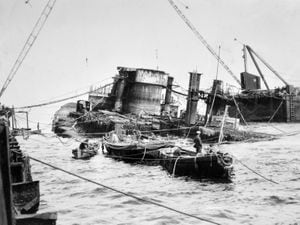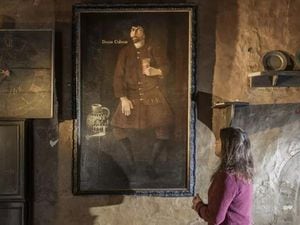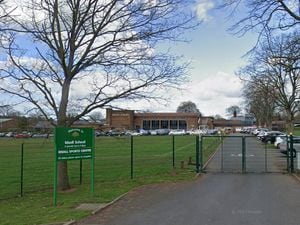The story of the Wolverhampton genius who raised the German fleet from the sea bed
And up she rises…

This picture from our archives captures the moment of triumph for Wolverhampton scrap man Ernest Cox, who owned a significant part of the German navy in the 1920s.
The trouble was, it was at the bottom of the sea.
In the world’s biggest maritime salvage operation, he brought up the ships one by one.
But this behemoth of the deep fought back and it took him years to land this particular “catch".
The raising of the Hindenburg was an epic feat which sealed his reputation.
The story began on June 21, 1919. The German fleet had languished for months at anchor at the British naval base of Scapa Flow in the Orkneys while the victorious Allies decided what to do with it.
Rear Admiral von Reuter hatched a secret plan to, as he saw it, save the honour of the German Navy. On that day he sent out a secret signal to scuttle the fleet. Before the British could intervene the German ships started to list and settle in the water, with the sailors taking to the boats.
Afterwards 1,740 German officers and men involved were interned at Park Hall and Henlle Camps, Oswestry. The deliberate sinking of the German ships was seen as typical "Hun treachery" and there was considerable local hostility.
The Shrewsbury Chronicle of July 4, 1919, reported: "It is persistently rumoured that Admiral von Reuter is allowed considerable liberty, being permitted the use of a motor car within the confines of the huge Park Hall Camp, where he is in captivity, but this is denied by the military, who assert that all the scuttlers are under strict confinement.
"A German naval officer of high rank and wearing a typical 'Tirpitz' beard, was driven to a bank in Oswestry on Saturday morning.
"He was mistaken for von Reuter, and in an incredibly short space of time several hundreds of people assembled in the street and made a hostile demonstration when the stranger left the bank.
"Women, men, and youths yelled and booed, and one man succeeded in striking him on the shoulder with his fist, while another threw a well-aimed cabbage which landed under the ear.
"Superintendent Taylor, Sergeant Pearce, and other policemen were quickly on the spot and prevented further violence."

Ernest Cox had been born on March 12, 1883, at 55 Pool Street, Wolverhampton. In the years after the Great War he was in the scrap metal business in a big way. Looking for more things to scrap, he bought a floating dock, initially intending to scrap it.
Hearing of the sunken German fleet – an absolute scrap gold mine – he began to formulate a plan to use the dock to raise the ships, which must have seemed madcap to others as he had zero experience in marine salvage.
In 1924 the Admiralty, which thought he must be a bit eccentric, agreed, as a start, to sell him 26 destroyers and two battleships.
The way Cox approached the task was groundbreaking and pioneering, and his very lack of knowledge in a field in which there were few experts opened the door to his adopting novel and innovative ways of tackling the formidable problems.
He began with the smaller ships, the destroyers, the method essentially involving creating a cradle for the sunken vessel and then lifting it from the bottom.
But then he moved to the Hindenburg. No ship of its size had ever been salvaged. Nearly 700ft long, the 28,000 ton battlecruiser entered service too late to fight at the Battle of Jutland and had been involved in minor operations in 1917, never firing a shot in anger.
Although lying in 70ft of water, she was so big that her funnels and superstructure poked teasingly clear of the surface. To raise her Cox decided to plug all the holes and pump her out so she would rise to the surface.

But the Hindenburg still had some fight in her and repeated efforts to float her in 1926 took on the flavour of trying to land a thrashing big fish, with the ship heeling over and threatening to capsize. The final straw was a storm which blew up at a critical point. Cox had to let her go again and admit defeat.
He moved on to relatively easier catches, and it was four years before he had another go, using the same method. After some heartstopping moments and various setbacks the SMS Hindenburg was finally brought back to the surface on July 15, 1930. Cox had won.
The story of the raising of the Hindenburg was told as part of a 2005 book by Tony Booth called "Cox's Navy."
"Cox's radical techniques were now being copied by other salvers around the world as the news of his successes spread," he said.
"He was well and truly at the pinnacle of his salvage career. He had nothing more to prove to the experts who once laughed at the jumped-up scrap dealer from Wolverhampton with an insane plan to achieve what they could not even contemplate.
"After four long years and many disappointments, the gamble had eventually paid off – professionally, at least."
After conquering the Hindenburg, Cox moved on to the salvage of some of the other larger German warships.
Nothing was to be taken for granted, with each ship presenting its own challenges, and one constant being that the work was dangerous. In those days before scuba equipment divers worked at the end of air lines and there were a variety of ways to die, including the particularly gruesome "helmet squeeze" which is probably best not to describe in case you're eating your tea.
There were indeed several accidents, some fatal, during the salvage.
In total, he raised 32 warships from the bottom and became something of a national hero, but then turned his back on Scapa Flow and concentrated on his scrapyards, which he ran from Acton, London.
The final balance sheet for his Scapa Flow efforts showed that they had cost £500,000 at contemporary prices, but because of fluctuating scrap metal prices his firm Cox & Danks' declared earnings from them were £490,000 – a £10,000 loss, although Tony Booth's book implies that there may have been something more to it than that.
"What he lost in financial reward Cox certainly made up for in prestige and worldwide acclaim for his somewhat headstrong, but extremely successful, approach to marine salvage – if, indeed, after all the final accounting was considered, he really did present a complete picture of his profit and loss."
Cox's knowledge and experience thereafter made him a go-to person on salvage matters for some years. In 1949 he sold Cox & Danks and eventually settled in Torquay where he died on February 17, 1959.
He had come a long way from the Wolverhampton lad brought up in a cramped Victorian terrace.
His old school, Dudley Road Free School, became Blakenhall community centre, and a plaque on the building commemorates him.
It reads: "Ernest F G Cox, 1883-1959. Engineer and Marine Salvage Expert, educated her 1890-1897."





